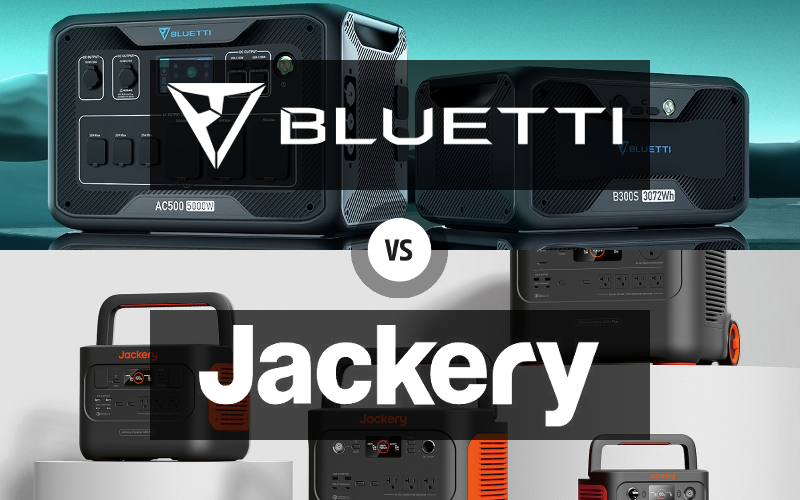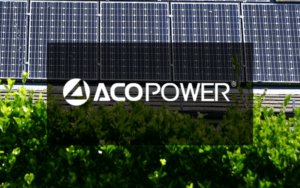Searching for the ideal brand to meet your off-grid or solar power needs? BLUETTI and Jackery are two of the biggest and most respected brands in the industry, each offering a broad range of portable power stations and solar generator kits tailored for various uses. In this comparison of BLUETTI vs Jackery, we will provide a deep-dive into both brands, looking at their strengths across key product categories to help you make a decision.
We’ll begin with a summary of each brand’s product ranges, then move into a comparison across each product category. We will provide our recommendations for different categories (high power, mid-range, and budget needs). We’ll also look into the specifications, design, functionality, and customer experiences to give you a complete understanding of what you can expect from each brand.
We always recommend purchasing BLUETTI and Jackery products directly from their official websites. While there are many reputable wholesalers and third-party sellers, including Amazon, buying from these sources may invalidate your warranty and make it more challenging to contact customer support. For this reason, any and all links in this article will take you straight to the brands’ websites.
For more information on each brand’s warranty policies, visit BLUETTI‘s and Jackery‘s Warranty Policy webpages.
Having only been founded in 2019, BLUETTI has already established itself as domineering brand in the field of solar technology, offering a wide range of products designed to meet the needs of different users. From compact power stations to large-capacity solar generators, BLUETTI’s product offerings are known for their durability, high efficiency, and innovative features.
Founded in 2012, Jackery has similarly become a big name in the portable power industry. Known mostly for its user-friendly design and reliability, Jackery’s products cater to a wide audience, from casual users to more hardcore adventurers. The brand’s commitment to quality and sustainability has made its solar generators and panels popular choices among those looking for portable, clean energy options.
Introduction to BLUETTI vs Jackery
Jackery are typically associated with more budget-friendly, easy-to-use portable power solutions, whilst BLUETTI have a bigger range of more powerful offerings. When comparing BLUETTI vs Jackery, it’s important to consider a range of factors, including product range, power output, battery capacity, and overall value. Both brands offer solutions designed to cater to the diverse needs of their customers, making the choice between them dependent on specific requirements and preferences.
The following sections will look at the specifics of BLUETTI and Jackery products, examining their features, advantages, and potential drawbacks. This comprehensive analysis aims to equip readers with the knowledge to make an informed decision when choosing between BLUETTI vs Jackery for their portable solar power needs.
Product Ranges
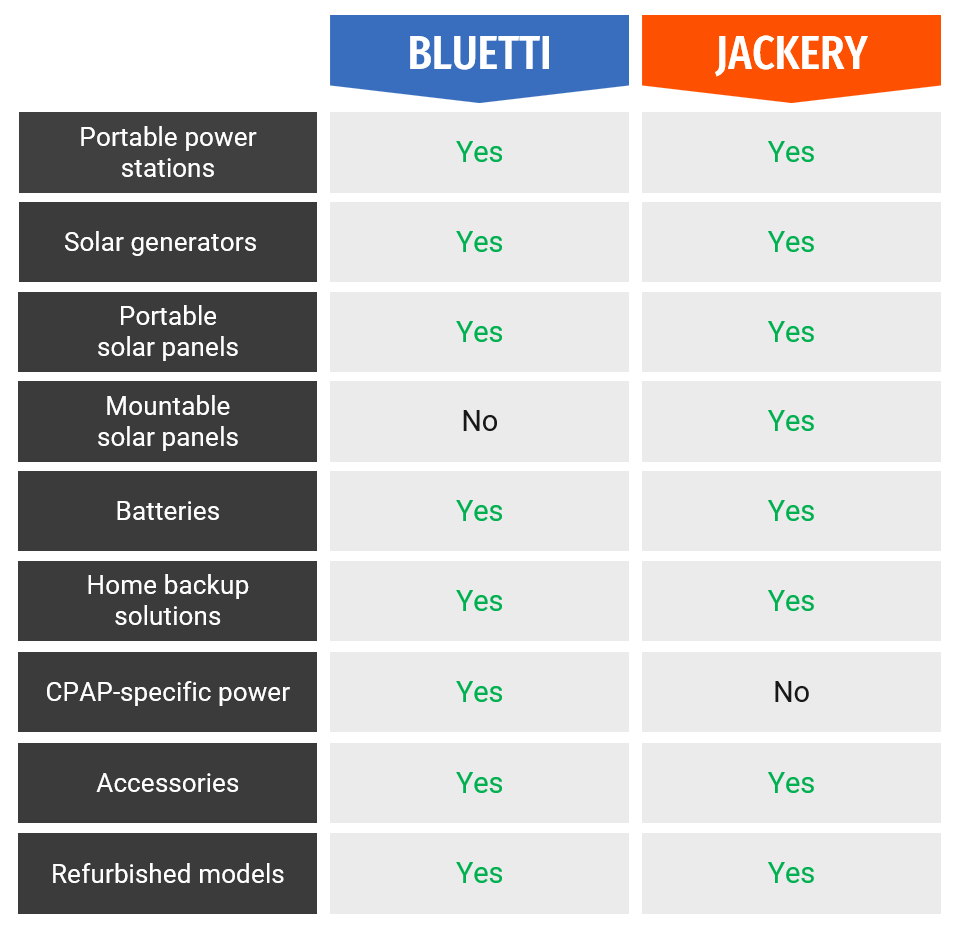
As the above chart shows, both BLUETTI and Jackery have very similar product ranges. Both brands offer products within the categories of portable power stations, solar generators, portable solar panels, batteries, home backup solutions, and accessories. Both brands also offer refurbished models at a discounted price, and neither brand offers mountable solar panels.
The only real difference in product offerings is that BLUETTI have CPAP-specific power solutions, whilst Jackery do not – but that’s not to say that Jackery’s ‘generic’ power stations aren’t compatible with CPAP machines.
BLUETTI vs Jackery: Portable Power Stations
A portable power station is a compact, off-grid system which uses a rechargeable battery to provide electricity. Compared to power banks, which often only provide USB outlets, portable power stations have a higher output, a larger capacity, and additional outlets so that they can power a range of appliances. The other significant difference lies in that they can be recharged by a range of different inputs – usually AC, car, and solar power.
Unlike simple batteries, portable power stations have additional components, such as a charge controller and an inverter. The charge controller regulates the power input and conversion from AC or DC sources, while the inverter converts the stored DC power back into AC power, which allows it to power standard appliances.
When selecting a portable power station, you should consider the following key metrics:
- Battery capacity (Wh): The total energy capacity of the portable power station, which determines how long it can power devices (measured in Watt hours).
- Output (W): The maximum power output of the portable power station, which affects the type and number of devices it can run simultaneously. Also consider surge power and higher-power modes (e.g. BLUETTI’s ‘Power Lifting Mode’).
- Battery chemistry: While this is tied closely to capacity and charging speed, you should always consider the battery chemistry of your portable power station, as this influences not only the durability of the product, but also the portability and safety. The most stable and hence safe battery type is the LiFePO4 (lithium iron phosphate), which is also the heaviest.
- Charging speed: How quickly the station can be recharged, which varies based on the charge controller’s efficiency and the type of recharging (e.g. AC, solar, car).
- Lifespan: How many charge/discharge cycles the portable power station can go through before the battery capacity is reduced to a specified percentage (e.g. 500 cycles to 80% capacity).
- Portability: A combination of factors including the weight, size, and ease of carrying. Typically, the higher the battery capacity of a portable power station, the heavier and larger it will be. Some larger models feature wheels for better mobility.
- Additional features: Includes the number and types of output ports (e.g. USB-A, USB-C), charging options (e.g. AC, solar, car), accessories, handle design, and extra functionalities like app integration for remote management.
BLUETTI's portable power stations
BLUETTI has an extensive range of portable power stations for off-grid and outdoor use. Their models vary by budget and capacity, from their AC2A model (300W, 204Wh) priced at $249 before discounts, to their AC200L model (2,400W, 2,048Wh) priced at $1,999. Many of their power stations are also expandable with additional batteries, such as the AC200MAX, which has expandable capacity from 2,048Wh to 8192Wh, starting at $1,699.
In terms of BLUETTI’s nomenclature, the majority of their power stations either start with ‘AC’ or ‘EB’. The AC series is their flagship and most popular model, whilst the EB series seems to have been discontinued (although existing EB models can still be purchased, subject to availability).
Additionally, some of BLUETTI’s power stations also have a letter suffix after the model name, most frequently ‘P’ and ‘L’. The ‘P’ suffix refers to their ‘Premium Series’, whose models feature a sleek design with orange embellishment (which actually makes them look a bit like Jackery products). The Premium Series is described as having faster charging capabilities, a powerful yet compact design, and power-lifting mode, however many of their non-Premium Series models still have these features. Furthermore, it is really not clear what the ‘L’ suffix represents, but it seems to be another variation of their Premium Series. For example, the AC200L, AC200P L, and AC240P all feature a 2,400W output, a capacity ranging from 1,843Wh – 2,304Wh, and are all priced at $1,999.
| Portable Power Station | Price | Output (W) | Capacity (Wh) | Max Solar Input (W) | AC input (W) |
| BLUETTI AC180 | $929 sale ($999 full price) | 1,800 | 1,152 | 500 | 1,440 (0-80% in 45 mins) |
| BLUETTI AC200L | $1,699 sale ($1,999 full price) | 2,400 | 2,048 | 1,200 | 2,400 (0-80% in 45 mins) |
| BLUETTI AC60 | $649 sale ($699 full price) | 600 | 403 | 200 | 600 (Turbo Charging, 100% in 1-1.5 hours) |
| BLUETTI AC2A | $179 sale ($249 full price) | 300 | 204 | 200 | 270 (Turbo Charging, 80% in 45 mins) |
| BLUETTI EB3A | $209 sale ($299 full price) | 600 | 268 | 200 | 430 (Fast Charging, 80% in 30 mins) |
| BLUETTI AC200MAX | $1,499 sale ($1,699 full price) | 2,200 | 2,048 | 900 | 500 (= total 1,400W max dual charging) |
| BLUETTI AC200P | $1,199 sale ($1,499 full price) | 2,000 | 2,000 | 700 | 400 (= total 1,100W max dual charging) |
| BLUETTI EB55 | $499 full price | 700 | 537 | 200 | 200 (= total 400W max fast dual charging) |
| BLUETTI EB70S | $449 sale ($649 full price) | 800 | 716 | 200 | (AC recharge in 4-4.5 hrs) |
| BLUETTI PS72 | $399 | 700 | 716 | 200 | 200 |
| BLUETTI AC50B | $399 | 700 | 448 | 200 | 580 |
| BLUETTI AC70 | $699 | 1000 | 768 | 500 | 950 |
| BLUETTI AC180T | $1,499 | 1,800 | 1433 | 500 | 1440 |
| BLUETTI AC240 | $1,899 | 2,400 | 1,536 | 1,200 | 2,200 |
| BLUETTI AC240P L | $1,999 | 2,400 | 2,304 | 1,200 | 2,400 |
| BLUETTI AC240P | $1,999 | 2,400 | 1,843 | 1,200 | 2,200 |
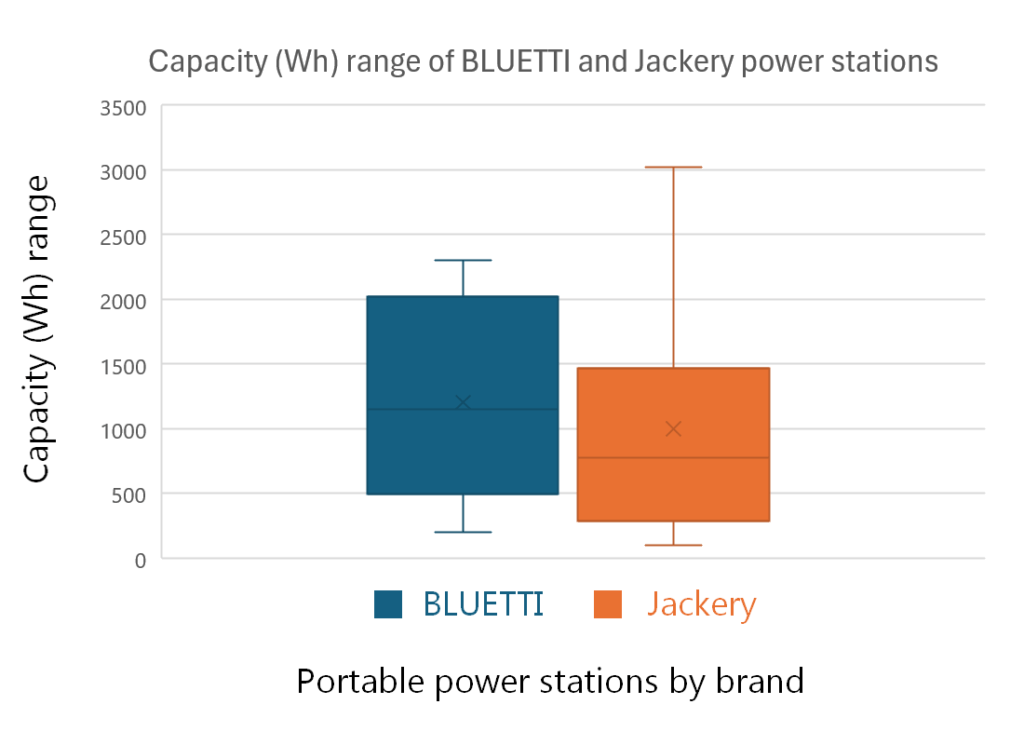
Jackery's portable power stations
On the other hand, Jackery has about the same number of different portable power station models available, but with an even wider range of price and capacity. At the lower end, they have their light and portable Explorer 100 Plus model (128W, 99Wh) priced at $149, and at the upper end, their Explorer 3000 Pro model (3,000W, 3,024Wh), priced at $2,799. The chart above shows the capacity distribution of BLUETTI and Jackery power stations.
As for Jackery’s nomenclature, their power stations are all named ‘Explorer’, followed by a number which roughly represents the capacity of the model – e.g. the Jackery Explorer 500 with 518Wh capacity, the Jackery Explorer 880 with 880Wh capacity, and the Jackery Explorer 1500 with 1,534Wh capacity.
Additionally, Jackery use the ‘Plus’ and ‘Pro’ suffix with some of their models, which seems to signify whether it’s a newer and improved version of the original model rather than denoting a markedly higher output or capacity. For example, the ‘Pro’ models seem to have slightly faster charging capabilities and more outlets than their original counterparts.
| Portable Power Station | Price | AC Output (W) | Capacity (Wh) | Charging Info |
| Jackery Explorer 2000 Plus | £1,999.00 ($2,199.00) | 3,000 | 2,042 | Solar: 2 hrs; AC: 1.7 hrs |
| Jackery Solar Generator 2000 Pro | £1,999.00 ($1,899.00) | 2,200 | 2,160 | Solar: <2.5 hrs with 6x200W panels; AC: 2 hrs |
| Jackery Explorer 1500 Pro | £1,499.00 ($1,699.00) | 1,800 | 1,512 | AC: 2 hrs |
| Jackery Explorer 1000 Pro | £1,099.00 | 1,000 | 1,002 | AC: 1.8 hrs |
| Jackery Explorer 1000 | £1,049.00 ($999.00) | 1,000 | 1,002 | AC: 7 hrs |
| Jackery Explorer 500 | £556.99 ($499.00) | 500 | 518 | AC: 7.5 hrs |
| Jackery Explorer 240 | £259.99 ($239.00) | 200 | 240 | AC: 5.5 hrs |
| Jackery Explorer 1000 Plus | £1,149.00 ($1,199.00) | 2,000 | 1,260 | AC: 1.6 hrs |
| Jackery Explorer 300 Plus | £319.00 ($299.99) | 300 | 288 | AC: 2 hrs |
| Jackery Explorer 100 Plus | £139.99 ($149.00) | 128 | 99 | USB-C: 4 hrs |
You might also be interested in reading our article on 6 Portable Power Station Dos and Don’ts to Maximize Efficiency.
BLUETTI vs Jackery: Solar Generators
The definition of ‘solar generators’ ranges slightly from brand-to-brand, depending on what’s contained in the box. For some brands, solar generators and portable power stations are synonymous. The short answer: solar generators are portable power stations that come with compatible solar panels.
Indeed, some may question whether they should truly be called ‘generators’, given by how much the solar variety differs from its traditional gas-powered counterparts.
BLUETTI and Jackery’s solar generator range are based on their portable power station models. For example, BLUETTI’s ‘AC200P Portable Power Station’ becomes the ‘AC200P Generator Kit’ when paired with solar panels and additional battery options.
For this reason, our picks for best solar generators from each brand are largely unchanged from the above. (However, please note that occasionally, not all portable power stations are offered as solar generator kits, and compatible portable solar panels by each brand must be purchased separately.)

If you’re interested in BLUETTI’s home backup range, check out our reviews on the BLUETTI EP900 and BLUETTI AC500.
BLUETTI vs Jackery: Solar Panels
BLUETTI's solar panels
BLUETTI have a handful of portable solar panels available, ranging from the PV120 (120W) at $299 to the PV420 (420W) at $999. All of their solar panels are monocrystalline silicon, which means they have up to 23.4% efficiency, and feature ETFE (ethylene tetrafluoroethylene) lamination. Some models, but not all, have IP65 certification meaning they’re splashproof – but you should always check the certification section of specific models to double-check before you buy. The same goes for compatibility with portable power stations and batteries, but BLUETTI are usually pretty good at letting you know which model of solar panel works with each power station.
Solar panel nomenclature is rather straightforward – they each begin with ‘PV’, meaning photovoltaic, followed by a number which represents the power (e.g. PV200 at 200W, PV350 at 350W). Some newer versions of models have a ‘D’ or ‘S’ suffix, and while it’s not clear what these letters actually stand for, they seem to be the premium versions which vary slightly in Open Circuit Voltage (OCV) and Short Circuit Current (Isc), as well as subtle differences in weight and design.
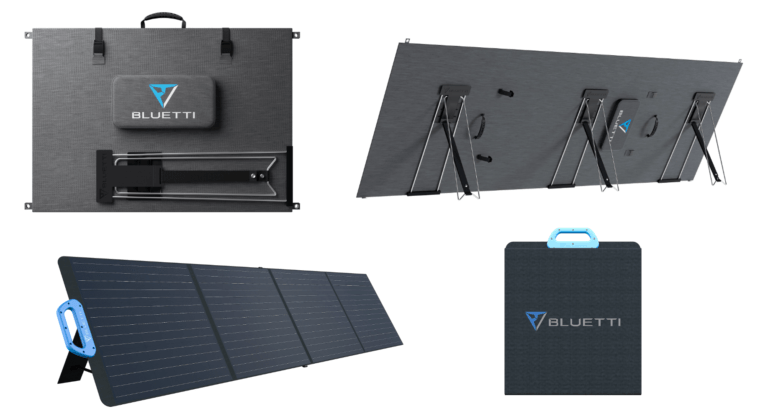
Speaking of design, BLUETTI solar panels feel robust and sturdy, and have excellent design for portability. Most come with built-in handles, a collapsible design (so you can carry them in a single handheld unit), and an easy-to-use kickstand which also allows you to adjust the angle of the panels.
Jackery's solar panels
As for Jackery, they have a narrower range of portable solar panels – about half the number of models that BLUETTI have, at the time of writing. These range from the SolarSaga 40W Mini Solar Panel at $129 to the SolarSaga 200W Solar Panel at $699. They are all monocrystalline, except for the SolarSaga 100 Prime which is bifacial (lending it an even higher efficiency), but they vary a little more in terms of design. For example, their SolarSaga 100 Prime Solar Panel is built with tempered glass rather than ETFE coating.
Jackery’s range is also generally more durable than BLUETTI’s range, with all of Jackery’s panels coming with either a IP65 or IP68 waterproof rating, and some additional shock-proof certifications. Unlike BLUETTI, Jackery also have one solar panel model which can be mounted to a surface – their extra-durable SolarSaga 100 Prime.
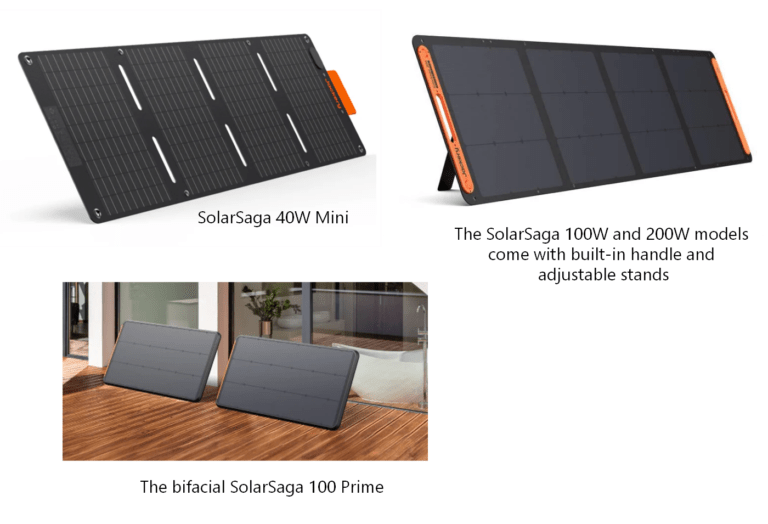
Jackery’s solar panels all have ‘SolarSaga’ in the name. The two standard models are the SolarSaga 100W and SolarSaga 200W, which both have built-in handles, and kickstands to stand the panels upright. The other two are slightly less user-friendly. The SolarSaga 40W Mini is, as its name suggests, extra small, and has no handle or stands to prop it upright – instead, you just unfold it and lay it down on a surface. The SolarSaga 100 Prime also has no built-in handle or stand, but it can be mounted at an angle (e.g. on top of RVs) to make the most of its bifaciality, or laid flat.
BLUETTI vs Jackery: Brand Highlights
What is BLUETTI known for?
In terms of visual design, BLUETTI products have very sleek aesthetics, featuring a minimalist black design with blue motifs. Unlike more conventional designs (in particular, EcoFlow and Jackery), BLUETTI’s power stations often integrate handles directly into the unit, giving them a streamlined profile which is ideal for transportation and diverse environments.
As for their product range, BLUETTI offers the same spread of product categories as Jackery, as we’ve discussed above. BLUETTI stands out as offering a wider variety of solar panel options in particular, allowing for greater flexibility in building custom solar setups. Although they have a number of lower-power and budget-friendly options, their product line also extends into higher-range offerings than Jackery. This is also apparent in their range of home backup products, which are built for much higher performance scenarios than Jackery alternatives.
What is Jackery known for?
Jackery products are equally easy to spot, with their power stations and solar panels featuring a distinctive black and orange color scheme. Their physical designs emphasize their practicality –handles on their power stations are external, making them easy to carry long distances. They also tend to be lighter on average than BLUETTI models.
While Jackery covers similar product categories, they tend to focus on the more accessible segment of the market, making portable power more available to casual users and those new to solar power. This point is obvious by looking at their solar panel range – their lowest-power solar panel is 40W whilst BLUETTI only goes as low as 120W.
It should be noted that both BLUETTI and Jackery are highly regarded in the renewable energy market, and have very similar reputations when it comes to customer service, trustworthy, and reliability. There are many solar power forums online (as well as Facebook groups) whose users will testify to this.
BLUETTI vs Jackery: Battery Chemistry and Longevity
Almost all of both BLUETTI and Jackery’s power stations and batteries now use LiFePO4 battery technology, a shift which reflects a broader industry trend towards more stable and safe battery compositions.
LiFePO4 vs. other battery types
Lithium Iron Phosphate batteries, also referred to as LiFePO4 or LFP, are known for their robust safety profile and longevity. These batteries are capable of enduring 3,000 to 3,500 charge cycles before their capacity drops to 80%. This is in stark contrast to older lithium-ion technologies and NCM batteries (nickel manganese cobalt oxide), which typically offer around 500 to 1,000 charge cycles.
In addition to longer life, LiFePO4 batteries also have a superior safety profile to their alternatives. They are less prone to overheating and are more stable under a broad range of temperatures and conditions, which reduces the risk of thermal runaway – a condition that can lead to battery fires.
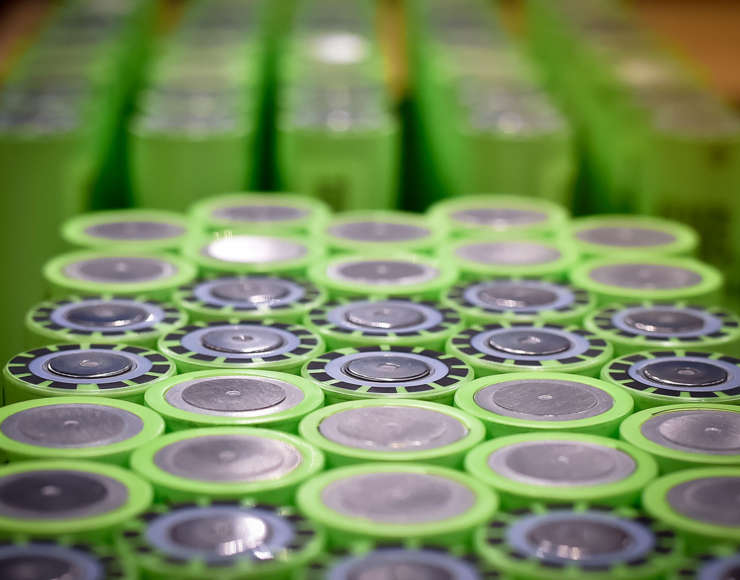
Drawbacks of LiFePO4 batteries
Despite their advantages, LiFePO4 batteries do carry some drawbacks. Primarily, they are significantly heavier and more expensive than their NMC and other lithium-ion counterparts. This increased weight can impact the portability of power stations, making them less ideal for lightweight applications where mobility is key. Additionally, the higher upfront cost may deter some consumers, especially those with limited or occasional power needs. While the long-term benefits like greater cycle life and stability often justify the initial investment, the cost can still be a barrier for broader adoption.
However, it is of our opinion that the safety and longevity of LiFePO4 batteries always justifies their extra cost and weight – but at the end of the day it comes down to your preferences and circumstances.
BLUETTI vs Jackery: Charging Options
BLUETTI's charging options
BLUETTI’s solar generators and panels support multiple charging methods, including solar, AC outlets, and car charging. Notably, BLUETTI’s products are renowned for their rapid recharge rates. For instance, the BLUETTI AC180 recharges from 0 to 80% in 45 mins with 1,440W AC Input, making it a standout for speed.
Furthermore, BLUETTI’s solar panels are designed with high-efficiency monocrystalline cells, ensuring maximum energy conversion even in less-than-ideal sunlight conditions. This efficiency not only speeds up charging times, but also extends the usability of their devices in diverse environments such as more cloudy conditions.
Jackery's charging options
Jackery’s portable power stations offer a similar range of charging options to suit various needs. Like BLUETTI, the majority of Jackery’s power stations can be charged via AC outlets, car, and solar panels. Whilst it really depends on the individual product, they also have good charging speeds. The Explorer 1000 Pro Solar Generator, for example, can be charged within 1.8 hours using its 4x SolarSaga 200W panels.
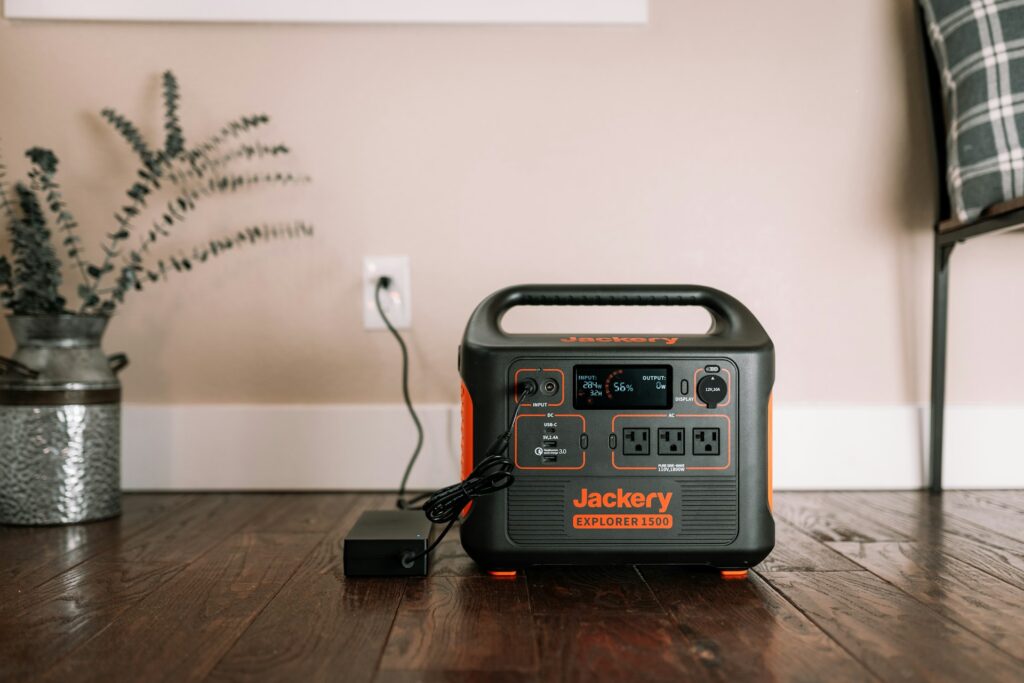
Both brands offer a wide range of charging options, including AC, solar, and car charging, with varying speeds depending on the output and capacity of their power stations. The charging options and speeds can differ significantly between individual products within each brand’s lineup. There is nothing concerning about either brand in this arena; both have standard ranges of charging options and speeds.
BLUETTI vs Jackery: User interface and ease of use
Bluetti's user interface
Many of BLUETTI’s products feature intuitive LCD screens that display all necessary information clearly, such as battery levels, input and output power, and remaining charge time. Further to this, some of BLUETTI’s latest models come equipped with touchscreens, enhancing the user interaction by making navigation through settings and modes a breeze. Furthermore, BLUETTI’s app integration allows users to monitor and control their devices remotely. The connectivity of their app varies by model – sometimes just Bluetooth, sometimes both WiFi and Bluetooth – so it’s always worth double-checking the specific model.
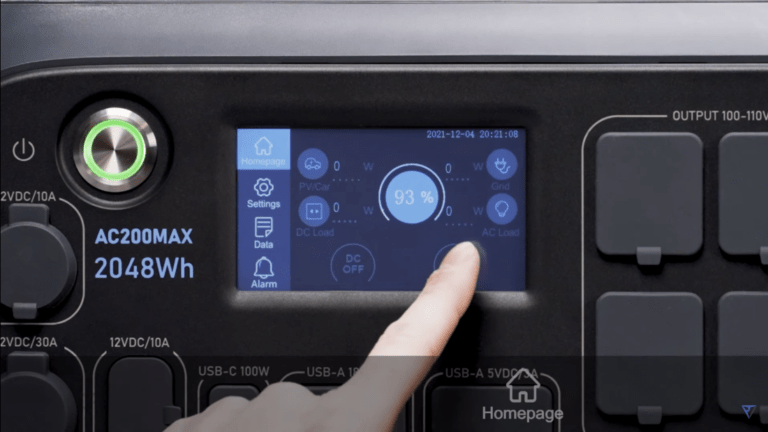
Jackery's user interface
On the other hand, Jackery focuses on simplicity and reliability in their user interface design. Their solar generators and portable power stations are known for their straightforward, intuitive LCD displays. Whilst not typically offering touchscreens like BLUETTI, these displays provide all the essential information without overwhelming the user, making Jackery products a great choice for those new to solar-powered devices.
Like BLUETTI, Jackery also provides app connectivity for real-time monitoring, allowing you to connect your device from anywhere through the Jackery app. This allows you to monitor device status, battery level, remaining time, temperature, and more.
BLUETTI vs Jackery: Conclusion and recommendations
At the end of the day, choosing between BLUETTI and Jackery really depends on your specific needs and what you value in a power solution. Both brands are highly respected in the solar power industry, and each offers reliable products designed to meet various energy needs, so you really can’t go wrong with either brand.
As a recap, BLUETTI can be distinguished by its high-capacity power stations, broad range of solar panels and solar generator kits, and home backup systems. Their units are also particularly sleek and stylish for those who care about aesthetics.
Jackery, on the other hand, might be the better choice for those who prioritize portability and budget-friendly options. Their products are particularly suited for light outdoor use and for those new to portable power stations, but they do offer higher-spec options for those interested.
Recommendations
-
- For high-end users and power enthusiasts: If your needs lean towards high-capacity, versatile power solutions for extensive outdoor use or home backup, BLUETTI is the recommended choice. Their advanced technology, robust build, and wide product range will serve your needs effectively, providing a reliable power source in various conditions.
- For casual users and outdoor enthusiasts: If you are new to solar power or prioritize ease of use, portability, and affordability for casual outdoor activities or emergency backup, Jackery offers an attractive range of products. Their user-friendly, budget-friendly options do not compromise on quality, making solar power accessible to a broader audience.
Ultimately, your choice should be guided by your power needs, budget, and preference for specific features. If you are already invested in one brand’s ecosystem, sticking with the same brand could ensure better compatibility and ease of use. Remember to always check for compatibility of solar panels with portable power stations before purchasing anything. Comparing individual models from each brand will also help you find the best option for your circumstances.
For further reading, you might be interested in:
Solar Trek is all about breaking down information about solar-powered brands and products into a helpful, easily digestible format. All of our content is totally objective, aimed at helping you to make the best purchasing decisions for your solar needs. If you click our links and make a purchase, we may earn some commission at absolutely no extra cost to you, but this does not interfere with our goals of providing 100% helpful, informative, and objective information.


